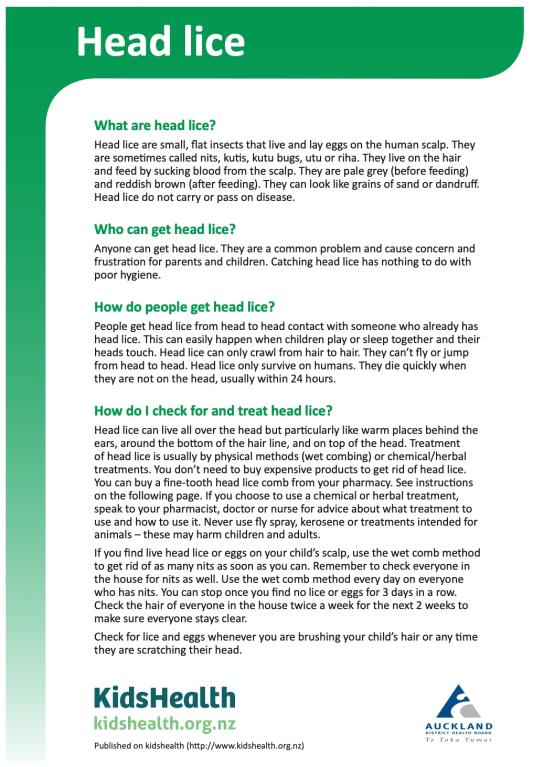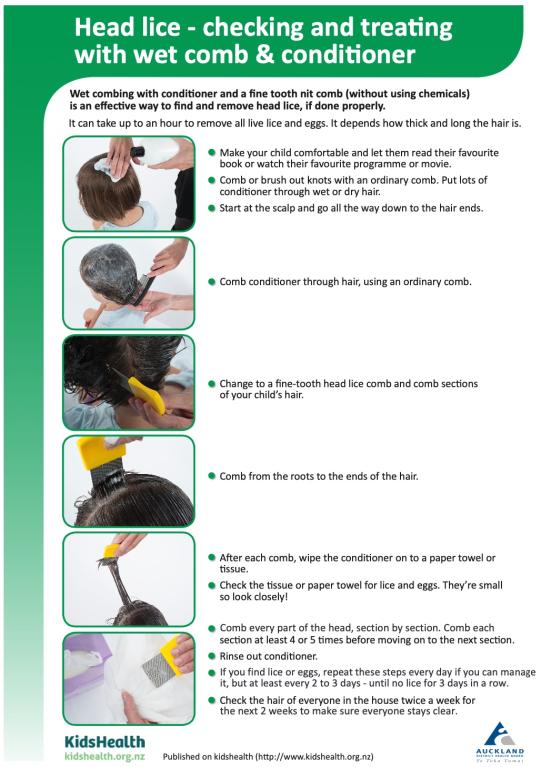Key points about getting rid of head lice in children
- head lice are small, flat insects that live and lay eggs on the human scalp - the scalp provides food and warmth for the eggs to hatch
- head lice are sometimes called nits, kutis, kutu bugs, utu or riha
- they are a common problem and cause concern and frustration for parents and tamariki
- anyone can catch head lice - catching them has nothing to do with poor hygiene
- head lice spread by crawling from the hair of one person to another
- if you find live head lice or eggs on your child's scalp, treat your child and check everyone in the house
- 4% dimethicone lotion is a very effective treatment that a health professional can prescribe, it's not an insecticide
- wet combing with cheap conditioner and a fine-tooth head lice (nit) comb is also an effective way to find and remove head lice, if done properly
- if you choose to use another chemical or herbal treatment, speak to a health professional for advice about what treatment to use and how to use it
- never use fly spray, kerosene or treatments intended for animals - these may harm tamariki and adults
What are head lice?
Head lice are small insects found on the human head. They grow to about the size of a pin head, sesame seed or grain of sand.
Head lice live on the hair and feed by sucking blood from the scalp. They are pale grey (before feeding) and reddish brown (after feeding). Head lice do not carry or pass on disease.
Who gets head lice
Anyone can get head lice. They are a common problem and cause concern and frustration for parents and tamariki.
Catching head lice has nothing to do with poor hygiene.
How people get head lice
People get head lice from head to head (hair to hair) contact with someone who already has head lice. This can easily happen when tamariki play or sleep together and their heads touch.
Head lice can only crawl from hair to hair. They can't fly or jump from head to head.
Head lice only survive on humans. They die quickly when they are not on the head, usually within 24 hours.
How to check for and get rid of head lice
Head lice can live all over the head but particularly like warm places such as:
- behind the ears
- around the bottom of the hair line
- on top of the head
They can look like grains of sand or dandruff.
Check out the 2 options for treating head lice below. Whichever treatment you use, you need to remove any eggs by hand. That's because eggs attach firmly to the hair. You can put conditioner or water on the hair before combing. This loosens the eggs from the hair and makes combing easier.
4% dimethicone lotion - to get rid of head lice
4% dimethicone lotion is a very effective head lice treatment that a health professional can prescribe. You only need to put it on your child's head twice - with a week in between each use.
Dimethicone Lotion For Treating Head Lice
Some head lice shampoos from supermarkets and pharmacies are becoming less effective because head lice have developed resistance to them. Dimethicone is not an insecticide. It kills head lice by suffocation and disrupting the ability of the head lice to regulate water. It is unlikely head lice will develop resistance, as they can with other products.
Wet combing with conditioner - to find and get rid of head lice
Wet combing with cheap conditioner and a fine-tooth head lice (nit) comb is also an effective way to find and remove head lice, if done properly. You don't need to buy expensive products to get rid of head lice. You can buy a fine-tooth head lice comb from your pharmacy. It can take up to an hour to do a wet combing session. It depends how long and how thick your child's hair is.
Wet Combing With Conditioner For Treating Head Lice
Checking and treating other family members for head lice
If you find head lice, you should check the rest of your whānau (family). If you find head lice on other members of your whānau, treat them all on the same day.
If your whānau has head lice, tell anyone who has had head-to-head contact with them, so that they can check and treat their whānau if needed.
Tell your school so that they can tell other parents to check their tamariki for head lice and treat if necessary.
Preventing head lice
It's very difficult to prevent - there is no product available that prevents head lice.
Tying long hair back and checking weekly for lice, using the conditioner and comb method, can help prevent the spread.
Once you think your child is free of head lice and eggs, make sure to check them once a week.
You don't need to wash clothing and bedding on a hot wash - it's unlikely to help prevent the spread of head lice.
Head lice resources for printing
Download and print the 2-page guide on head lice. The first page has information about head lice and the second page has a step-by-step guide to the wet combing technique.

Download and print the 1-page step-by-step guide to the wet combing technique. This handout doesn't include the extra information about head lice.

